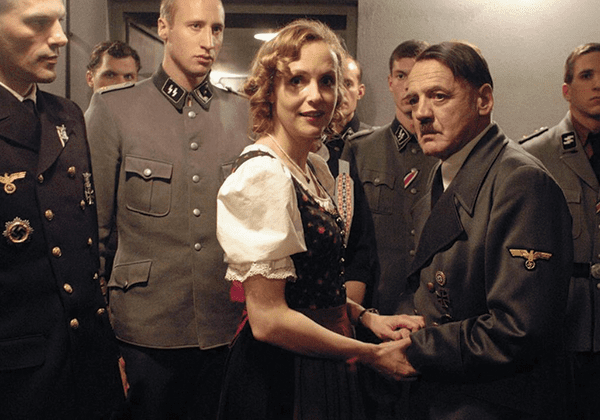A certain unflinching determination is required to make a film that has its outcome in the title. But in many ways, certainty is the very essence of Oliver Hirschbiegel’s project in Downfall. The film opens on a crumbling Nazi leadership, hurtling towards apocalypse as the thousand-year Reich is crushed beneath the treads of Soviet tanks. From an early scene, in which Hitler’s birthday is heralded by a thunderstorm of Russian artillery, there is no mistaking the fact that everyone in the infamous Führerbunker must flee or perish. In this regard, Downfall is a masterclass in relentless claustrophobia, as the audience cannot help but watch Hitler and his generals draw up pathetic counter-offensives with a gut-wrenching sense of empathy. True hopelessness is a hard feeling to shake, particularly under the shadow of the impending, faceless cataclysm that Hitler and his inner circle faced. Hirschbiegel’s skills as a director are in full throttle as he creates an environment more reminiscent of a horror film than an historical epic at times. But one inescapable question continues to haunt viewers as they watch the film: why do I feel sorry for the Nazis?
Half of the answer to this question is straightforward: competent filmmaking. Downfall isn’t a particularly cinematic film, with most of it being shot in the ruddy confines of Hitler’s bunker. A lot of the time the cinematography seems to be closer to a found-footage film than anything else, as handheld shots track characters frantically pacing through labyrinthian hallways. Beyond the cinematography, watching Bruno Ganz as Hitler is an absolute treat, as Ganz pours all of his energy into the performance. Downfall’s most famous scene, in which Hitler slightly loses his cool, has broken into the Anglosphere in the effective package of short memes with edited subtitles, becoming a popular way for people to react to any kind of current affairs, and causing major headaches for anyone trying to learn German from the film. While this scene seems almost impossible to take seriously given its status as a meme, in the context of the film it is more than natural; it is utterly visceral. Ganz manages to perfectly capture Hitler’s passion, egotism, viciousness and lunacy in an eerie way. Watching him is nothing short of delightful and terrifying. So, if Downfall’s problems don’t come from lazy direction or weak performances, there must be a more sinister source.
Downfall flirts with fascism in a way that creeps unnoticed onto the screen. It doesn’t come in the form of a huge lie, but it pulls on the fabric of history just enough to open a few tears. Take, for example, Albert Speer, Hitler’s architect and armaments minister of Nazi Germany. In Downfall, Speer acts as a rational counterweight to Hitler’s increasingly erratic decision making, culminating in an emotional scene in which Speer admits to Hitler that he has not only refused to pursue the mandated scorched-earth policy, but even actively hindered Hitler’s directives. This conversation, however, exists only within the pages of Speer’s post-war memoirs, wherein he carefully constructs the image of the ‘good Nazi’ for himself, depicting himself as an apolitical architect who was merely swept away with the cyclonic winds of the time.
A similar case is that of Wilhelm Mohnke, a general in the Waffen-SS, who, in Downfall, attempts to prevent the fanatical Volkssturm civilian recruits from dying weaponless against the Soviet colossus. Back in reality, however, Mohnke was found guilty of having killed Canadian prisoners of war (POWs) in 1944, and is also accused of having murdered British POWs after the Battle of Dunkirk. You wouldn’t know this from the film however, as a YouTube commenter shows when remarking “Mohnke was a good leader. His command of the ragtag force of SS, Volkssturm and Hitler Youth is testament to his leadership, resourcefulness and bravery.” Another commenter praises Speer’s pseudo-historical defiance, saying “Thank God Speer decided not to fulfil the Nero plans [scorched earth].”
This kind of thinking that Downfall has inspired in its audience very closely resembles the beliefs of the ‘clean Wehrmacht myth,’ a false narrative pushed after the war by German generals and NATO powers in order to free German war criminals for military service by denying involvement in war crimes and furthering an apolitical image for figures such as Speer and Mohnke. By romanticising the fanatical defense of Nazism, Downfall makes it eerily easy for its audience to sympathise with fascist murderers, often making no effort whatsoever to remind the audience of these figures’ crimes.
The danger of Downfall lies in this very lie. It distorts — perhaps intentionally, perhaps out of laziness — the Nazis’ reputation as unequivocally evil. It cannot be forgotten that the resistance to fascism in Germany didn’t come from the military or within the party itself, but from the millions of Jews and anti-fascist dissidents that perished in the flames of Nazism, flames that were fanned and stoked by these supposedly ‘apolitical’ figures.





